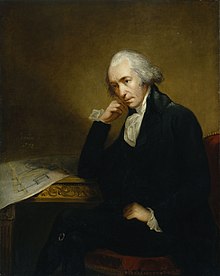
Back James Watt Afrikaans James Watt ALS ጄምስ ዋት Amharic James Watt AN جيمس واط Arabic جيمس وات ARZ জে’মচ্ ৱাট Assamese James Watt AST Ceyms Vatt Azerbaijani جئیمز وات AZB
| James Watt | |||
 Portrett av James Watt (1736–1819) av Carl Frederik von Breda | |||
| Fødd | 19. januar 1736 Greenock | ||
|---|---|---|---|
| Død | 25. august 1819 Heathfield Hall | ||
| Bustad | Glasgow så Handsworth i Storbritannia | ||
| Statsborgarskap | Storbritannia | ||
| Nasjonalitet | Skottland | ||
| Område | maskinteknikk, dampmaskin, Oppfinningar, instrumentmaker | ||
| Yrke | ingeniør, kjemikar, fysikar, oppfinnar, gründer, matematikar, teknikar | ||
| Institusjonar | University of Glasgow | ||
| Alma mater | University of Glasgow | ||
| Kjend for | Utbetring av dampmaskinen | ||
| Influerar | Joseph Black Adam Smith | ||
| Ektefelle | Ann MacGregor, Peggy Miller | ||
| Barn | James Watt, Margaret Watt, Gregory Watt, Janet Watt | ||
| Medlem | Royal Society Det franske vitskapsakademiet Royal Society of Edinburgh Lunar Society of Birmingham | ||
| Religion | Church of Scotland,[1] seinare deist[2] | ||
| Signatur | |||
James Watt (19. januar 1736–25. august 1819) var ein skotsk matematikar og ingeniør. Vidareutviklinga hans av dampmaskina, ein stempeldampmaskin i perioden mellom 1765 og 1769, vert rekna som ein sterkt medverkande årsak til den industrielle revolusjonen.[3] James Watt innførte omgrepet hestekraft for effekten til dampmaskinar. SI-eininga for effekt, watt, er oppkalla etter han.[4][5]
- ↑ Carnegie, Andrew. James Watt. The Minerva Group, Inc. s. 215. ISBN 0-89875-578-6.
- ↑ Dickinson, Henry Winram; Jenkins, Rhys; Committee of the Watt Centenary Commemoration (1927). James Watt and the steam engine: the memorial volume prepared for the Committee of the Watt centenary commemoration at Birmingham 1919. Clarendon press. s. 78. «It is difficult to say anything as to Watt's religious belief, further than that he was a Deist.»
- ↑ Kingsford, P. W. «James Watt» (på engelsk). Encyclopedia Britannica. Henta 25. september 2023.
- ↑ «James Watt» i Store norske leksikon, snl.no.
- ↑ Knudsen, Ole: James Watt i Den Store Danske i lex.dk. Henta 25. september 2023.